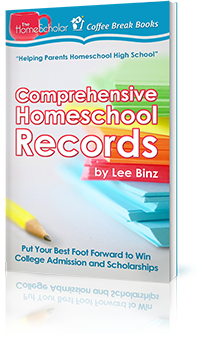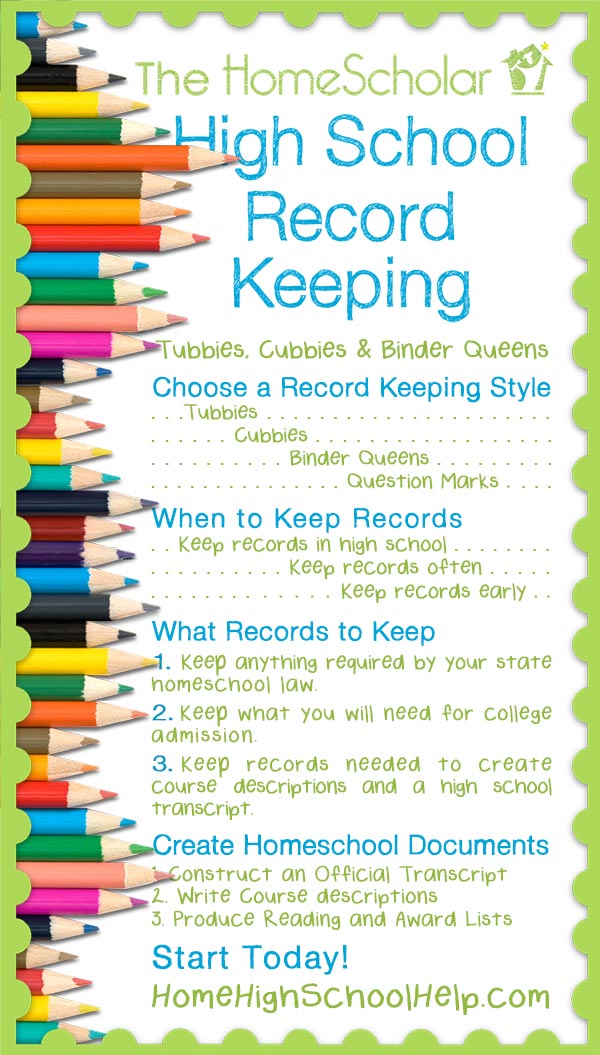Homeschool Record Keeping - In a Nutshell
You've probably given homeschool record keeping some thought, regardless of whether you have a perfectly organized homeschool. Whether you feel the panic, want to stick your head in the sand, or are confident about planning and your ability to carry it out, it’s important for every homeschool parent to consider record keeping in high school.
Homeschool Record Keeping: Cubbies, Tubbies, and Binder Queens
Perhaps it’s only a vague thought, and you say to yourself, “I’ll get to that someday.” But time has a way of sneaking up on you. Even if you are convinced your student will never go to college, chances are high that at some point in the future you will need to provide homeschool records of your student’s high school experience. You may need homeschool records for your child to become a camp counselor, or to get a “good student discount.” After high school, these records might be needed for a job application, graduate school, or as an employment requirement for a job they desire, even 10 years from now. Homeschool record keeping will ensure you’ll always be prepared.

Homeschool Records - Forgetting Large Chunks of Information
Homeschool record keeping is so important because it’s completely possible for a normal homeschool parent to accidentally forget large chunks of information. A few years ago, I was working on a transcript with a mom named Paula. She thought her child's transcript would be easy because she had been keeping records. In truth, her record keeping book was completely empty. We had to work through old receipts and curriculum records to create her child's transcript. We didn’t worry though, we simply discussed every subject area in detail, from algebra to American Sign Language.
Once the records were complete, she was so happy! As I was leaving, I asked, "What are you doing this weekend?" Paula didn't hesitate for a moment, explaining they were going to a Latin competition.
"Latin competition?" I said. "You never mentioned Latin!" That was how I discovered that her high school junior had already completed four years of high school Latin, and her mother had completely forgotten about it. A very large and important part of the child's transcript was missing, and would have stayed that way if I hadn’t asked about her weekend plans. It's not as if the four years of Latin was a repressed memory of something horribly traumatic. It was obvious the student enjoyed Latin - that's why she was still competing, and why they were both looking forward to the weekend.
This is why we need to keep high school records. Keeping records will help us remember our children's homeschool experiences so we can create great transcripts and course descriptions. Record keeping is important so we don't forget broad swaths of learning, such as four years of Latin.
Keep high school records so you can make a transcript that reflects the courses you taught and so you don't short-change your student. Paula is a gifted home educator, loving mother, and she had done an exceptional job homeschooling her children, yet even she forgot four years of Latin. Never underestimate the human ability to forget, because it can happen to anyone!
You can avoid a homeschool record keeping crisis of your own. Learn how to keep high school records so this doesn't happen to you.
How to Keep Homeschool Records

Being a binder queen requires a minimal investment. A few dollars will get you everything you need: a 3 ring binder, a set of dividers, and some notebook paper. All it requires is a few minutes each week, making sure the binder is prepared and used instead of ignored. Using a binder system is a convenient way to keep work samples and graded work from every class. If colleges ever want to see a sample of work from Latin or Macroeconomics class, simply reach into the binder for one.
Simple is better. My binders were 3 inch, 3 ring binders, each with a simple label such as "Kevin 2020-2021." At the beginning of the year, label each divider in the binder. In the front of the binder, label a section for the transcript. Then arrange a section for everything required by your state law. You might include a divider for your Declaration of Intent to Homeschool, immunization records, or annual testing records.
Next, label a divider for each class you intend to teach. This includes English, math, social studies, science, foreign language, P.E., fine art, and electives for the year. You can record test scores or grades for each lab or report on a simple piece of notebook paper. Store significant papers behind each divider to keep as work samples.
You don’t need to keep everything, but it can be helpful to keep papers that you evaluated. Later in the year, perhaps in the spring, go back over what your child learned and develop a course description for each class. If you started a class but didn’t finish, throw that divider away; there’s no reason to record what was not done.
Keeping a place for my records helped me to keep them up to date. Every month, I gathered all the papers my kids produced and gradually filled up each 3 ring binder. As the year progressed, I was able to see which sections were filling up and which sections were blank. Once the blank sections were identified, I could concentrate on developing records for those sections. When the art divider was empty, I assigned my children a one page paper on an artist. When the music section was blank, I had them list their performance-ready piano pieces and added their Christmas Recital Program to it.

Keeping Records While Homeschooling
Keep high school level academic records. Homeschool record keeping is different from scrapbooking – it’s not an artistic endeavor. There are three big high school record keeping categories.
- Keep anything required by your state homeschool law. This may include a declaration of intent to homeschool or an immunization record.
- Keep what your child will need for college admission. Be prepared, because you don’t always know what the future will hold.
- Keep records needed to create course descriptions and a high school transcript. You are the high school, so you are in charge of these records.
It’s relatively simple for many classes. Keep any tests or papers your child has written, and you're done! For other classes you may want to keep lab reports, tests, research papers, or short essays. Some classes don't include paper assignments, and record keeping will require some creativity. The credit value of courses such as P.E., fine arts, and other electives may be hard to quantify unless you keep track of hours. You can also make a list of the activities completed or resources used in each class.
One mother asked what records she should keep for her child learning how to cook at home. Think outside the box, and consider what your child does to learn. This child created a menu, went grocery shopping, and cooked using recipes. Those are all great homeschool records! Save the menu, the shopping list, and photocopy recipes for culinary arts class records.
There are many other ways to keep records. Keep a printout of the curriculum you purchase. List every book your child buys, uses, or reads for pleasure. Track hours spent on subjects, projects, or activities that aren't bookish. Keep online descriptions from internet or co-op classes. Photocopy textbook covers and table of contents. Keep any assignment sheets or schedules you create.
Instead of writing down what you want your child to do in the future, you can write down what your child did after the work is completed. (This will help parents who are conscientious, but not good at planning ahead.) Have your child keep a journal of school work, including books, assignments, and experiences. Most students do some of their work on the computer, so be careful to save it in a school file on the computer or printed out in your filing box, or both.
Create Homeschool Transcripts and Records
Once every spring, create and update the important high school documents you will need to demonstrate your child’s awesome home education.
1. Transcript
Plan to create an Official Transcript. This is a simple Word document, created on your home computer, with the words “Official Transcript” in the title.
2. Course descriptions
Each class description should have three main ingredients. First, write a descriptive paragraph about what your child did. This is a simple fifth grade writing assignment, not a college thesis, so don’t overthink it. Second, include a list of what you used, from textbooks to supplements or experiences. Third, describe how you graded or evaluated, remembering that there should be more than merely tests to influence the final grade.
3. Reading and award lists
Make a list of the books read each year. This is easier when you keep all your library and curriculum purchase receipts each year. Keep a list of the activities your child is involved in and the awards or volunteer hours they earned in each activity.
When to Keep Homeschool Records
Keep records early. Record keeping is not a switch that you can suddenly turn on; it can help to practice. I started training myself to keep records when my children were in seventh grade so I would be competent by the time they were in high school. If your child is in seventh or eighth grade, practice keeping your homeschool records as if they were already in high school. Be prepared for anything as you move forward. It’s common for homeschoolers to do some high school level work in middle school.
Keep records often. It's a rare person who updates homeschool records every day, but every parent can manage keeping up with records every month or two. As you train yourself to keep records, strive to keep something to document every subject your child learns.
Keep records in high school. Homeschool records become critical once a student begins high school as they are part of the transcript that will be shared with colleges. Begin your transcript as soon as your child is in 9th grade, or at age 14. Update the transcript and course descriptions every spring from 9th through 12th grades, until high school is complete.
Start Record Keeping Today
Recommended Resources

Learn secrets for making colleges and universities stand up and take notice of your student…no matter HOW HUMBLE your homeschool!
You can offer something more desirable than perfect SAT®/ACT® scores and a dozen AP® classes. In fact, there is something so basic about your quirky little homeschool, yet so important to colleges that you probably wouldn't guess it in a thousand years! Almost every homeschool family I've met has "got it" in abundance. Very few, however, know how to communicate it effectively. You can create homeschool records that demonstrate the sum of all your hard work.

In this book, you will learn how college admission has changed and what colleges now look for in prospective students, little known insights into the mindset of college admissions officials and how you can use them to benefit your child, and the core elements of a comprehensive homeschool record that will amaze and impress colleges. You will be relieved at how achievable it is to create beautiful records and how they can give you a real advantage in the college admissions game.

You CAN craft high school transcripts and records that gain choice college admission and win BIG scholarships. Lee Binz, The HomeScholar, has helped thousands of parents create outstanding homeschool transcripts and records. Her proven system will teach you how to present your child to colleges in the best possible light. You'll learn how to build a winning homeschool transcript, regardless of your homeschool methods or style, how to create credible grades and credits, even if you don't give tests, and how to provide the exact records colleges are looking for.

 Login
Login





